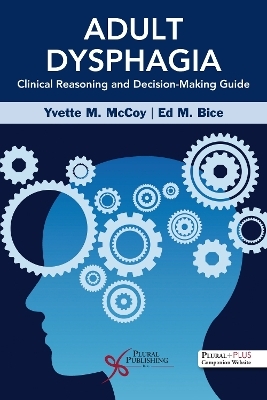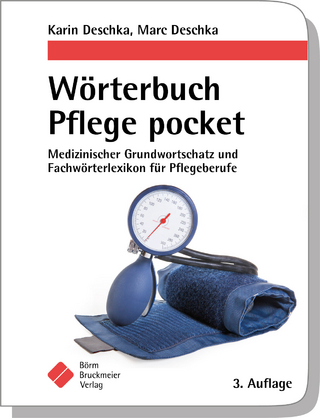
Adult Dysphagia Clinical Reasoning and Decision-Making Guide
Plural Publishing Inc (Verlag)
978-1-63550-692-1 (ISBN)
Adult Dysphagia Clinical Reasoning and Decision-Making Guide is the ideal resource for assessing and treating swallowing disorders. Readily accessible for day-to-day evaluation, this one-of-a-kind text gives clinicians quick access to key clinical information to help them think critically and provide actionable solutions for their patients. With a focus on the clinical process and implementing sound, clinical reasoning skills to inform decision-making, this resource aids speech-language pathologists in developing situation-based assessment and treatment plans.
Compact and easy to use, this professional guide can be leveraged as a practical tool by clinicians to facilitate positive, actionable patient outcomes for treating dysphagia in adults. Utilizing case studies with clinically relevant charts, diagrams, and flow sheets, this text helps speech-language pathologists develop a clinical process that involves critical thinking. With essential, evidence-based material for swallowing assessment and treatment, as well as alternate treatment solutions to implement in their clinical caseload, clinicians will acquire informed clinical reasoning and decision-making skills.
The PluralPlus companion website for this text includes interactive case studies. Recognizing that there are many possible solutions to treating a particular problem, the interactive case studies expand on information within the resource with case analysis and alternate solutions. Immediate feedback for choices will suggest further considerations and additional options to guide clinicians to think critically about how clinical decisions are made.
Key Features:
Case studies
Simple diagrams to describe complex, abstract concepts
Features “Deeper Dive” opportunities to go beyond the essential material
Inclusion of clinical notes and boxed focal points for practical application
PluralPlus Online Ancillary Materials:Clinicians: Case studies
Yvette M. McCoy, MS, CCC-SLP, BCS-S, is an Assistant Clinical Professor of Speech-Language Pathology in the College of Health at Moravian University. She currently holds her board certification in swallowing disorders. Ms. McCoy has numerous peer-reviewed publications and serves on the American Board of Swallowing and Swallowing Disorders Executive Committee as Secretary and the Pennsylvania Speech-Hearing Association as Vice President of Membership and Ethics. She has volunteered her time on various committees for the American Speech-Language-Hearing Association, Dysphagia Research Society, and has been invited to present her work at both state and national conferences. Ed M. Bice, MEd, CCC-SLP, is a Clinical Consultant for IOPI Medical and works clinically at a nonprofit speech and hearing clinic. He has experience in various settings, including acute care, outpatient, home health, and skilled nursing. Mr. Bice has held various leadership positions, including Vice President of Clinical Services and Chief Operating Officer. He has been a guest on national and international dysphagia podcasts and has published numerous articles in peer-reviewed journals. Mr. Bice teaches swallowing courses at the University of Maryland, has served as an expert witness, and has been an invited speaker for universities, state, national, and international conventions.
Preface
Acknowledgments
Reviewers
Chapter 1. Screening and Assessment: The Diagnostic Process
The Purpose of Screening and Assessments: What Is the Difference, and Why Should Clinicians Care?
Clinical Swallow Evaluation (CSE)
Sensory Testing During the CSE
Imaging Assessment Tools
Choosing the Test
Reference
Chapter 2. Introduction to Analysis
Clinical Swallow Evaluation (CSE) Analysis
Methods for Analyzing MBSS
The Dynamic Grade of Swallow Toxicity (DIGEST)
Analysis of Swallowing Physiology: Events, Kinematics, and Timing for Use in Clinical Practice (ASPEKT-C)
Methods for Analyzing FEES
Visual Analysis of Safety and Efficiency (VASES)
Timing Measures
References
Chapter 3. Collecting and Interpreting Data
Assessment and Differential Diagnosis
Individualized Treatment Planning
Baseline Assessment
Establishing Attainable Goals
Measuring Progress
Providing Evidence of Efficacy
Interdisciplinary Planning
Documentation and Legal Considerations
Investigation and Enhancement of Quality
Education for the Patient
Deciding What Data to Collect
Documentation and Interpretation of Data
Collecting Anecdotal Evidence to Build Experience
Summary
Conclusion
References
Chapter 4. Creating a Plan
Putting the Patient in the Center
Supporting Patient-Centered Care
Ethical Considerations
Selecting the Appropriate Intervention
Understanding Anatomy and Physiology
Motor Learning
Neuroplasticity
Exercise
Summary
Examining the Research and Evaluating Interventions
References
Chapter 5. Implementation
Establishing Therapy Goals
Therapy Tools
Intervention Dosage
Summary
References
Index
| Erscheinungsdatum | 29.05.2024 |
|---|---|
| Verlagsort | San Diego |
| Sprache | englisch |
| Maße | 152 x 229 mm |
| Themenwelt | Medizin / Pharmazie ► Allgemeines / Lexika |
| ISBN-10 | 1-63550-692-1 / 1635506921 |
| ISBN-13 | 978-1-63550-692-1 / 9781635506921 |
| Zustand | Neuware |
| Informationen gemäß Produktsicherheitsverordnung (GPSR) | |
| Haben Sie eine Frage zum Produkt? |
aus dem Bereich


